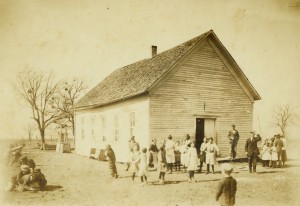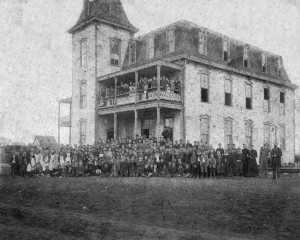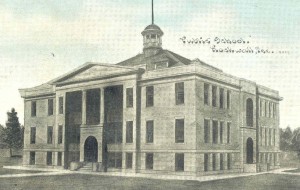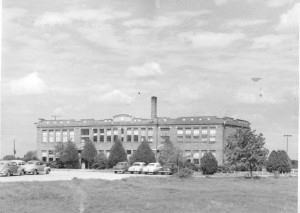History of Rockwall Independent School District
-
The Rockwall Independent School District, situated in Rockwall County, Texas, comprises approximately two-thirds of the county’s area and shares the county’s boundary lines on the north, west, and south. The eastern boundary of the district is an irregular line running through the town of Fate, Texas, north and south to those respective county boundary lines. In earlier years, numerous county schools, all of which were consolidated into the Rockwall School District in the late 1940’s and early 1950’s, dotted the countryside now claimed by the district.
The first documented schools, which were established within the boundaries of the present district, were the Willow Springs School, founded in the late 1840’s and located near the present city of Heath, and the Eddleman Kindergarten, founded in the early 1850’s, located in the city of Rockwall.
Another school in Rockwall was the Butler Institute, named for John Butler, who in 1853 donated land for the purpose of the construction of a school. The Butler Institute, according to early records, was used as a place of worship by all denominations of churches in the city of Rockwall. The building, which housed the Butler Institute, was the first structure built specifically for the purpose of education. The Butler Institute was later known as the Union School.
In 1862 the Bruce School, also known as the Thompson School, was built approximately two and a half miles north of Rockwall. The Bruce School burned and was replaced by the Truitt School, later named the Locust Grove School.

In 1859, Mr. C.L. Jones, a citizen of Rockwall, conveyed to the Masonic Lodge property located at the corner of San Jacinto and Washington Streets, and specified the building of a Masonic Hall and a school. History relates that the construction of the building was an item of special interest, since it was a two-story structure, quite unusual at the time for a community the size of the city of Rockwall. The Masonic Lodge was located on the second floor of the structure and the building’s first floor housed the school, named the Hartman and Slaughter Academy. The Academy served the city’s student population until the 1870’s when the two-story building was razed. During the decade of the 1880’s, school was conducted in the Rockwall Baptist Church and another school held classes in the Rockwall Christian Church.
In the mid-1880’s, a three-story, wooden school was built in the city of Rockwall, and, in 1887, Professor G.H. Stovall was hired as the first Superintendent of the Rockwall Public Schools. Professor J.K. Wells, a well-known educator, succeeded Professor Stovall as superintendent in 1889 and remained in that capacity until 1893, when he resigned in order to establish his own Wells College, or Rockwall College, as it was also known. Wells College, a private institution noted for scholastic excellence, operated successfully alongside the Rockwall Public Schools for many years.

It is appropriate that a history of the Rockwall Independent School District includes specific mention of the country schools, which ultimately were consolidated into the district. Pioneer families of the area were vitally interested in educational opportunities for their children. Transportation in those years was difficult; hence, small county schools flourished throughout the area. Many of the county schools were named for a teacher who held classes, a donor who provided land, or a geographical location. Some notable county schools serving the area of the present district were: McCreary School, Davis School, Locust Grove School, Prairie View School, Fate School, Hebron School, Chisholm School, McClendon School, and Willow Springs School. The Willow Springs School later merged into Heath School. State funds and local county revenues financed the county schools. A Board of Trustees governed each school, and the County Superintendent of Schools was the elected county judge. County schools were located approximately one and one half miles apart, a practical means of reducing the distance required by a student’s walk to schools.
The school served as the social center of the locale, and school programs were often presented for the community’s enjoyment. Some of the county schools had ten grades, and a highlight of the year was the senior play. Most of the county schools had only seven grades, after which the student attended another county school, or if transportation permitted, or boarding in Rockwall was obtained, the student attended the Rockwall Public Schools for the remaining grades. The public schools in Texas had only eleven grades until the 1930’s when the twelfth grade was added.
Educational institutions in the area of the present district were thriving at the turn of the century. In 1908, Rockwall residents approved and issued bonds in the amount of $25,000 to provide funds for construction of a new three-story brick building for the Rockwall Public Schools. The building, located at Fannin Street where the newly completed City of Rockwall municipal facility exists, was equipped with electricity, plumbing, and an auditorium. It served as the campus home of Rockwall Public School students, grades one through eleven. Chapel services were held at the school once each week, at which time local pastors and members of the faculty offered lectures. Local professionals and others from the business community were invited to speak at the chapel services.

In 1925, a two-story high school was built on Clark Street. Classes for eighth, ninth, tenth, and eleventh grade students were moved to the new building named Rockwall High School. The Fannin Street building continued to house grades one through seven and became known as the Rockwall Grade School.

J.A. Wilkerson came to the Rockwall Schools in the late 1920’s as a math teacher and coach. In 1934, he assumed duties as superintendent, math teacher, and football coach. Under his leadership, the already established football tradition gained momentum and more dedicated fans. During the 1940’s the district, led by Superintendent/Coach Wilkerson and aided by citizens of the community, designed and constructed a new football stadium on property east of the Rockwall High School (presently the Hobart Wisdom Stadium). More than thirty years later, a new football stadium was built and named Wilkerson-Sanders Memorial Stadium in honor of Superintendent/Coach Wilkerson and Harvey Sanders, a local businessman and avid Yellowjacket supporter.
In 1935, the Rockwall Schools, by then Rockwall Independent School District, purchased its first school bus, and the students from the county schools were permitted to attend the city schools for a fee, which included tuition and transportation. Student services were expanding, and in 1938, the school board approved the establishment of a lunchroom at the Rockwall Grade School. The cost of a lunch was ten cents.
By 1947, twenty-three county schools were operating within the bounds of the Rockwall ISD. The twelfth grade had been added to the high school curriculum, and an active movement began for consolidation of the county schools into RISD. When the official vote for consolidation was conducted, eighteen county schools favored consolidation and five schools opposed it. The twenty-three county schools were then consolidated into RISD. Consolidation brought growth to the district, and construction of a new elementary school was begun. Several buildings were moved to Rockwall to provide temporary classrooms for elementary school students while construction on the new building progressed. The Rockwall Elementary School on Interurban Street (presently Dobbs Annex) was opened in the fall of 1950. The Fannin Street building was closed and razed, and until 1965, when a new high school was built (presently Herman E. Utley Middle School), the district’s facilities consisted of only two buildings in the city the Rockwall Elementary School and the Interurban Street and the Rockwall High School on Clark Street.
When Rockwall High School (located on Townsend Drive, formerly High School Drive), was opened in 1965, the Clark Street Building became the Rockwall Junior High School. It served as such until it was razed in the late 1960’s in preparation for the active building program planned for the 1970’s, when the district would experience its most rapid growth in student population that has continued to the present.
In the more recent decades, Rockwall ISD has expanded tremendously. In 2005, the district opened its second high school located in the community of Heath. Rockwall-Heath High School now serves all RISD students south of Interstate 30. In 2013, the district opened Billie Stevenson Elementary. The district currently has 19 campuses comprised of 13 elementary schools, three middle schools, two high schools and one alternative school.
The History of the Rockwall Schools is a compilation of information gathered for the district through various historical resources.

